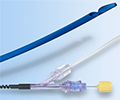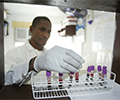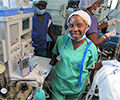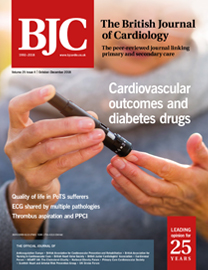Editorials
Clinical articles
News and views
Topics include:-
- Cardiovascular outcomes and diabetes drugs
- Quality of life in PoTS sufferers
- ECG shared by multiple pathologies
- Thrombus aspiration and PPCI

December 2018 Br J Cardiol 2018;25:127–9 doi:10.5837/bjc.2018.030
Sean L Zheng
Abstract

The paradigm for glucose control in type 2 diabetes has been based on historic and landmark studies demonstrating the unquestionable microvascular benefits of good glycaemic control.1-3 However, whether better control improves survival and prevents cardiovascular events has been less consistently shown, with one notable study, ACCORD (Action to Control Cardiovascular Risk in Type 2 Diabetes), showing an increased risk of cardiovascular death with tight control.2 Over the past few years, a number of randomised, placebo-controlled, cardiovascular outcome trials (CVOTs) testing novel glucose-lowering agents have demonstrated beneficial effects on mortality and cardiovascular events. This has prompted a change in emphasis away from solely targeting glycaemic control in diabetes, and focusing on reducing cardiovascular events and improving survival.
|
Full text
Clinical articles
Back to top
December 2018 Br J Cardiol 2018;25:140–2 doi:10.5837/bjc.2018.031
Toby Flack, Jamie Fulton
Abstract

Postural orthostatic tachycardia syndrome (PoTS) can be defined as tachycardia with or without hypotension in the upright posture, and more comprehensively as a manifestation of a wider dysautonomia. The scope of this article is to characterise patients with PoTS and look at patient-rated responses to treatment.
This research comprised a postal survey, sent to patients with diagnosed PoTS at a tertiary hospital in Southwest England. We collected data on the demographics of patients, time to diagnosis, methods of diagnosis, treatments and response to treatment.
PoTS has an impact on quality of life, with patients communicating a drop in quality of life from 7.5 to 3.75 on a 10-point scale. From 40 respondents, 29 patients describe their symptoms improving since diagnosis, with self-rated day-to-day function improving from 3.21 to 6.14 (on a 10-point scale) after initiating treatment.
Many patients experience a delay in receiving a diagnosis with PoTS, and present multiple times to a variety of healthcare professionals. With a simple bedside diagnostic test (sitting and standing heart rate), there is scope to improve the time taken from developing initial symptoms to diagnosis, treatment and an improvement in quality of life.
|
Full text

December 2018 Br J Cardiol 2018;25:152–6 doi:10.5837/bjc.2018.032
Telal Mudawi, Mohamed Wasfi, Darar Al-Khdair, Muath Al-Anbaei, Assem Fathi, Nikolay Lilyanov, Mohammed Elsayed, Ahmed Amin, Dalia Besada, Waleed Alenezi, Waleed Shabanh
Abstract

Thrombus aspiration during primary percutaneous coronary intervention (PCI) has been extensively studied. Conflicting results have consistently emerged, hence, no clear guidance has been produced. The authors have examined several key clinical trials and meta-analyses, and discovered, arguably, major flaws within the designs of most trials, thus, accounting for the persistently discordant results. The authors conclude that there is some evidence to support the selective use of thrombectomy in primary PCI but a large-scale trial with the appropriate patient selection criteria is needed in order to substantiate or refute the argument.
|
Full text
December 2018 Br J Cardiol 2018;25:159–60 doi:10.5837/bjc.2018.033
Richard Armstrong, Kevin Walsh, David Mulcahy
Abstract

Presentation of an interrupted aortic arch in adulthood is rare, and, up until, recently the only treatment strategy was through surgical repair. Advances in percutaneous interventions for congenital heart disease have included the percutaneous repair of coarctation of the aorta – from straightforward luminal narrowing through to full aortic interruption.1-3 We present a case of a 28-year-old man who was diagnosed with a complete aortic interruption and successfully percutaneously treated.
|
Full text

October 2018 Br J Cardiol 2018;25:147–9 doi:10.5837/bjc.2018.026
Ijeoma Angela Meka, Williams Uchenna Agu, Martha Chidinma Ndubuisi, Chinenye Frances Onyemeh
Abstract

Open-heart surgery is a major surgical procedure that requires intensive patient monitoring. Clinicians require prompt laboratory test results to assist them in this monitoring. Timeliness of result delivery is of great importance in taking prompt clinical decisions. We set out to evaluate the performance of the support laboratory before and after domiciliation at the cardiac centre using turnaround time (TAT) of electrolytes and liver function tests as benchmarks.
This hospital-based descriptive study was carried out at the University of Nigeria Teaching Hospital (UNTH), Enugu. The authors conducted a desk review of laboratory records for electrolytes and liver function tests from March 2013 to July 2017. Relevant laboratory personnel were also interviewed to ascertain types of equipment used and possible causes of delay at different stages of transition during the period under review. The TAT was calculated as the time from sample reception to time of dispatch of results.
Between 2013 and 2014, TAT for electrolytes and liver function tests were ~2 and ~6 hours, respectively. In 2015, TAT reduced to ~1 hour for electrolytes and ~1½ hours for liver function tests. Between 2016 and July 2017, TAT further reduced to ~10 minutes for electrolytes and ~30 minutes for liver function tests.
In conclusion, we were able to demonstrate improvement in performance of the support laboratory as shown by a reduction in TAT following the transition from the main laboratory to being domiciled in the cardiac centre.
|
Full text

October 2018 Br J Cardiol 2018;25:150–1 doi:10.5837/bjc.2018.027
Mark G MacGregor, Neil Donald, Ayesha Rahim, Zara Kwan, Simon Wong, Hannah Sharp, Hannah Burkey, Mark Fellows, David Fluck, Pankaj Sharma, Vineet Prakash, Thang S Han
Abstract

Myocardial perfusion scintigraphy (MPS) is a non-invasive method that can be used to assess reversible left ventricular myocardial perfusion defect (<20% indicates limited and ≥20% indicates extensive ischaemia), and left ventricular ejection fraction (LVEF) at rest and at stress. Data on the utility of MPS used to stratify cardiac risk prior to abdominal aortic aneurysm (AAA) repairs are limited. We evaluated MPS as a stratification tool for patients scheduled for endovascular aneurysm repair (EVAR) or open repair, between 2013 and 2016 at Ashford and St Peter’s NHS Foundation Trust, and 4.9 years (median 2.8 years, interquartile range [IQR] 2.1–3.8) cardiovascular events (n=15, 17.9%) all-cause mortality (n=17, 22.6%). Of the 84 patients recruited (median age 75.7 years, IQR 69.4–79.6), 57 (67.9%) had limited and 27 (32.1%) extensive ischaemia, 62 (73.8%) underwent EVAR and 22 (26.2%) open repair. Compared with open repair patients, EVAR patients were older (median age 70.6 years vs. 76.4 years, p=0.015), had higher rates of extensive ischaemia (13.6% vs. 38.7%, p=0.025), and abnormal LVEF reserve (LVEF at stress minus LVEF at rest ≤0: 40.0% vs. 76.6%, p=0.011), while having lower rates of 30-day postoperative major adverse cardiac events (13.6% vs. 3.3%, p=0.040) but no difference for cardiovascular events (p=0.179) or 4.9 year all-cause mortality (22.7% vs. 22.6%, adjusted hazard ratio 0.80, 95% confidence interval [CI] 0.22 to 3.20, p=0.799). Our findings indicate that MPS provides valuable information for AAA repair procedure.
|
Full text
October 2018 Br J Cardiol 2018;25:143–6 doi:10.5837/bjc.2018.028
Debjit Chatterjee, Priya Philip, Kay Teck Ling
Abstract

This is a case series of 10 patients who presented with the same electrocardiogram (ECG) manifestation of new-onset giant T-wave inversion and QT prolongation over a period of 24 months in a district general hospital. This unique ECG manifestation has been described with several cardiac and non-cardiac conditions.
|
Full text
October 2018 Br J Cardiol 2018;25:157–8 doi:10.5837/bjc.2018.029
Allam Harfoush
Abstract

Stunned myocardium is a rare, but serious, medical condition, and requires emergency intervention. Short periods of hypoperfusion may lead to a prolonged cardiac hypokinesia (hours to days), even though the perfusion is retained eventually. In other words, although the coronary circulation is retained, the hypokinesia remains. It might be considered as a case of prolonged post-ischaemic dysfunction.
In this case, a 60-year-old woman, visiting her siblings, presented with severe dyspnoea and cyanosis to the emergency department. Pulmonary oedema was diagnosed, and transthoracic echocardiography (TTE) showed general hypokinesia and reduced ejection fraction (15%), nevertheless, sequential TTE monitoring after the required medical intervention revealed a continuous improvement, with a 45% ejection fraction three days later and a specific anterior wall hypokinesia, solely.
In conclusion, rapid diagnosis and treatment are essential for stunned myocardium, as these could change the progress of the clinical condition.
|
Full text
News and views
Back to top
November 2018 Br J Cardiol 2018;25:131–132
The National Institute of Health and Care Excellence (NICE) has published a new guideline on the diagnosis and management of chronic heart failure in...
November 2018 Br J Cardiol 2018;25:131–132
Blood clots are the second most common cause of preventable mortality in cancer patients. Approximately 4% to 20% of cancer patients experience venous thrombosis,...

November 2018 Br J Cardiol 2018;25:131–132
A new study, from the Global Capnography Project (GCAP) and published in the journal Anaesthesia (doi: 10.1111/anae.14426), has identified a need for...
November 2018 Br J Cardiol 2018;25:131–132
Less than 5% of interventional cardiologists attempt left main bifurcation percutaneous coronary intervention stenting procedures because it is so complicated, according to estimates from...
November 2018 Br J Cardiol 2018;25:131–132
Clinicians who use handheld devices to ‘listen’ to the blood flow in patients’ lower limbs now have an online teaching aid that will improve...
November 2018 Br J Cardiol 2018;25:133
Topics covered in brief in this issue include: self-monitoring of type 2 diabetes cuts costs; rivaroxaban licensed in patients with CAD or PAD; new...

October 2018 Br J Cardiol 2018;25:135–7
Very high levels of high-density lipoprotein (HDL), the lipid that has been considered ‘good’ cholesterol, may be associated with an increased risk of...
October 2018 Br J Cardiol 2018;25:135–7
Rivaroxaban, the direct oral, factor Xa inhibitor, does not reduce the risk of a composite end point of survival, myocardial infarction (MI) and...
October 2018 Br J Cardiol 2018;25:135–7
The use of the oral anticoagulant rivaroxaban in medically ill patients for 45 days following hospital discharge showed there was no significant difference...
October 2018 Br J Cardiol 2018;25:135–7
“Usually”, appears to be the answer according to 10-year results from the Registry Of Pregnancy And Cardiac disease (ROPAC) a worldwide, prospective registry...

October 2018 Br J Cardiol 2018;25(4)
‘All you need to know about heart failure – in one day’ was the promise of the 10th British Society for Heart Failure...
October 2018 Br J Cardiol 2018;25:135–7
This year’s meeting of the European Society of Cardiology (ESC) was held in Munich, Germany, from 25th–29th August...









